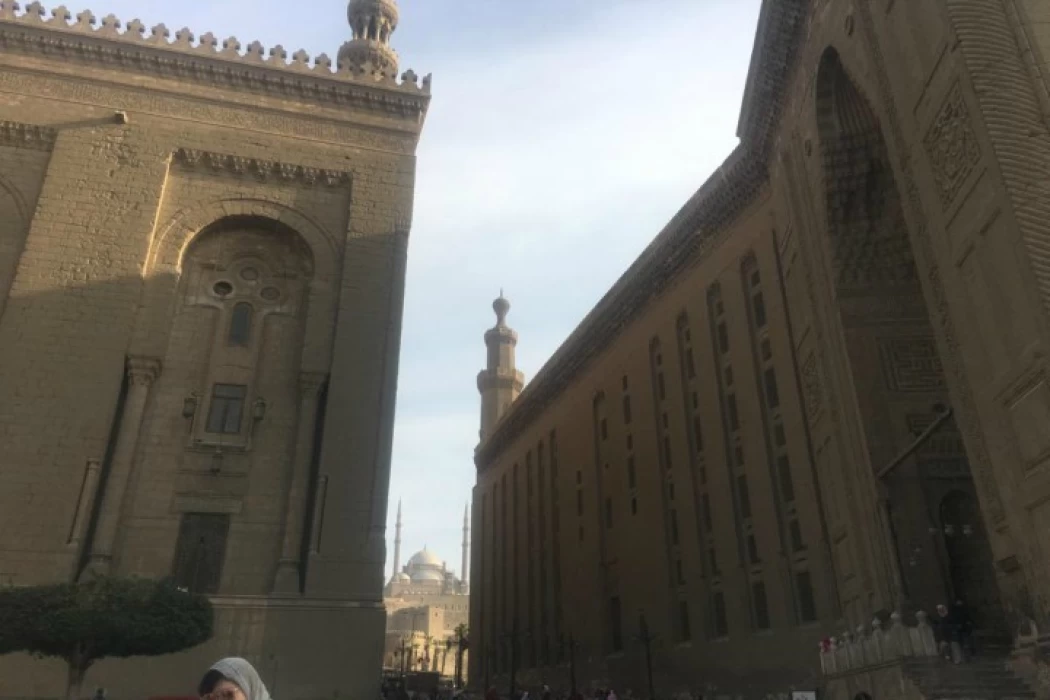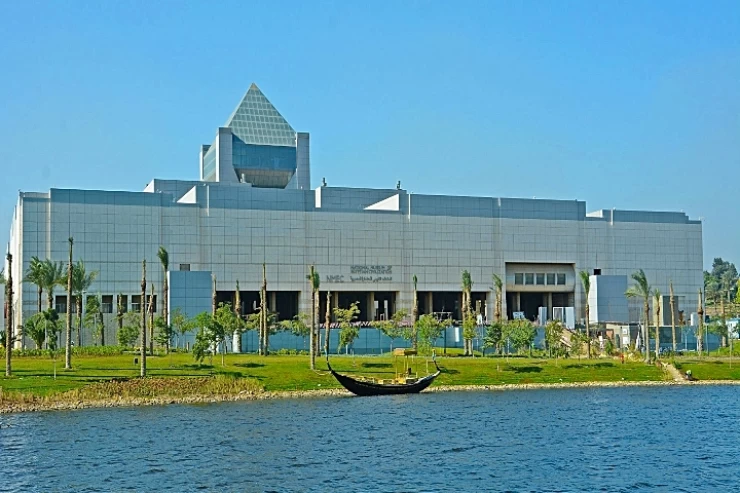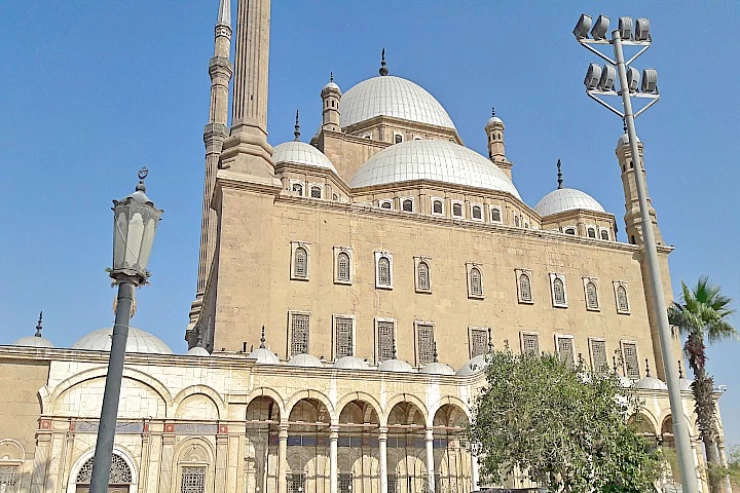
Sultan Hassan Complex
Sultan Hassan Complex
The Sultan Hasan Mosque-Madrasa, located in Salah al-Din Square in Cairo's historic district, is a sizable mosque and religious educational institution. Built during the rule of Bahri Mamluks from 1356 to 1363, it was commissioned by Sultan an-Nasir Hasan. The mosque, known for its vast dimensions and innovative architectural elements, continues to stand out as one of Cairo's most remarkable historical landmarks.
Inside Sultan Hassan Complex
The Sultan Hassan Complex is distinguished by its impressive size and intricate decorations, establishing it as a valuable example of ancient Islamic Art within Islamic Cairo buildings. In a book about Egypt, "Gomar" talks about the Mosque-Madrasa of Sultan Hasan. This detail makes it an important destination on Egypt trips as it highlights the Sultan Hassan Mosque & Madrasa's (Masjid al-Sultan Hasan Cairo) vibrant Islamic history.
The Royal Mosque, also known as Al Rifai Mosque, is a well-visited site near Sultan Hassan Complex.
Ancient Cairo showcasing Islamic elements.
Because of its towering dome, the minaret is considered one of Cairo's most magnificent buildings, thanks to its height, width, opulence, and adornments. Al-Maqrizi described it as a Muslim shrine not officially acknowledged in Islam, looking like a mosque yet worth visiting on your trips in Cairo. Standing out as one of the most unique attractions in Cairo, the tallest entrance in Islamic Cairo also holds the title as the largest building in the area. The compound consists of a Musque, buildings for education, and lodgings for students and teachers to reside in overnight. Four schools offer instruction in the four Sunni legal traditions. Exploring the Mosque of Sultan Hassan during your Egypt day tours is an essential destination in Cairo and Islamic Cairo, and could be considered one of the top attractions worldwide due to its beauty. The walls stand at a towering 36 meters tall.
The Mosque and Madrasa of Sultan Hassan is one of the most stunning examples of Islamic architecture in Cairo, and it is not surprising that the mosque is situated around the Citadel of Saladin, in the interior of Old Cairo. The complex embodies the epic proportions of Mamluk architecture and is famous for its great scale, beautiful intricate patterns and detail, and its past. Visitors around the globe make pilgrimages to the beauty and history of this architectural and cultural masterpiece, which is the pride of the Mamluk Sultanate.
Historical Overview
This mosque and khanqah compound construction was commissioned by Sultan Hassan bin al-Nasir Muhammad around the year 1356 AD, and he intended it to be more than a mosque as it would serve as a madrasa (school of study) for the four major Sunni sects of Islam: Hanafi, Maliki, Shafi’i, and Hanbali. The construction of the tomb was commenced in the 1356 Christian era, which took around seven years to complete. It was also used as a place to learn and worship. But the bad part was that, alas, within a matter of hours, after the Sultan ordered his last and grandest design, the Sultan was assassinated, thus enhancing the myth.
The complex was built in one of the cities that over the years have suffered many interruptions within its history, internally due to earthquakes as well as military sieges, some of which rendered its architectural design adversely. But it has remained a significant symbol of Mamluk rule and devotion and continues to be open for worship and visitors.
While the Sultan Hassan Complex has much to offer, its enormous scale is undoubtedly the most impressive feature. The main entry that is just under 26 meters in height leads to a courtyard that is surrounded by walls that rise to a height of 36 meters. The entire mosque covered about 7900 square meters, making it one of the biggest mosques in the globe. The building’s symmetrical stone elevation and rich use of geometrical decor and ornamental monuments are typical Mamluk architectural designs.
Also, within the mosque’s interior—except for the one iwab—which houses four schools of Sunni Islam and a large central courtyard, which is encircled by four iwans. The Iwan located at the center pointing to Mecca is enhanced with elaborate stucco work and marbles, as well as a decorated'mihrab.'.’ The courtyard is also properly arranged with the help of vertical members in the form of columns. The guests will also admire the lofty walls of the space, which have curved ceilings, creating an almost ethereal feeling in the room.
The organization, which is popularly referred to as the madrasa or Islamic institution in its primary sense, was one of the objects of the original vision of the complex. So all four iwans also served as classrooms for one of the Sunni judicial schools. This period also explains the presence of such illustrious personages in the inner chambers surrounded by students hailing from every corner of the Muslim world due to its esteem as the pinnacle of education.
The institution committed to the good health of its students as well. This implied that in addition to regular classes being offered, nutrition, dormitories, and a reading room were also provided to the students. The madrasah is covered by Koranic verses placed on the walls as ornaments and motivational resources for the student scholars who were within its confines.
Equally intriguing is the tomb of Sultan Hassan, which is another distinguishing element of the Sultan Hassan Complex. The tomb is in the back of the main prayer room and is said to be one of the best preserved examples of Mumluk burial architecture. The dome is surmounted by a giant dome that is 21 meters in height and is embellished with beautiful arabesques and inscriptions. Based within the mausoleum, there lies the sarcophagus of Sultan Hassan, encased in walls of marble embedded with Mamluk-style masterpieces.
Interestingly, Sultan Hassan’s body was never interred in this mausoleum, as he was killed before the complex was completed, and his remains were buried elsewhere. Nevertheless, the mausoleum remains a symbolic resting place and is a beautiful tribute to his memory.
The Sultan Hassan Complex is a superlative work of Islamic art and architecture, with every detail thoughtfully designed and executed to fit the Mamluk style. The walls and ceilings are clad in arabesques, geometric designs, calligraphy, and other typical components of Islamic art. The fishtail and stucco carving works, embellished on the surfaces, unequivocally demonstrate the exceptional artistry that went into building the entire complex.
Among the dominant artistic aspects, one cannot miss the beautiful wooden mashrabiya, which has elaborate floral and geometric carvings in it, encouraging the eye to explore its design. In addition to enhancing the beauty of the complex, these screens also provide ventilation as well as privacy. Another thing that adds beauty to the mosque is its mihrab, which is made of marble and embellished with decorative panels and mosaics that instill a certain level of spirituality.
















